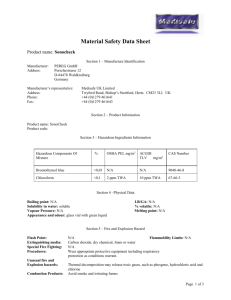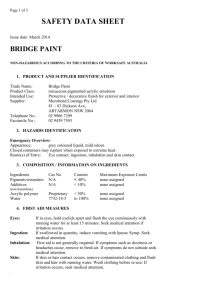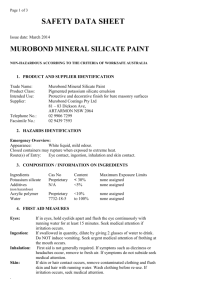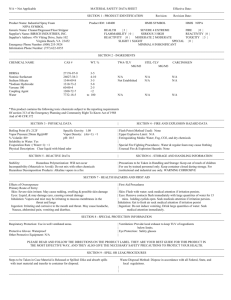battery fluid, acid
advertisement
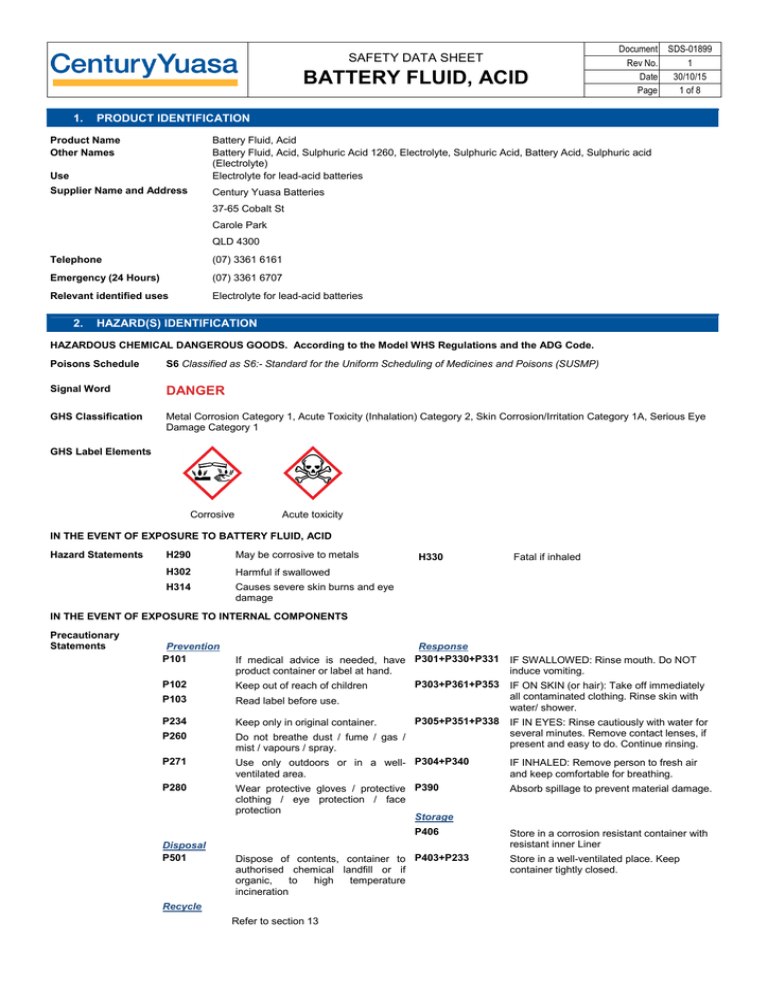
SAFETY DATA SHEET BATTERY FLUID, ACID 1. Document SDS-01899 Rev No. 1 Date 30/10/15 Page 1 of 8 PRODUCT IDENTIFICATION Product Name Other Names Use Battery Fluid, Acid Battery Fluid, Acid, Sulphuric Acid 1260, Electrolyte, Sulphuric Acid, Battery Acid, Sulphuric acid (Electrolyte) Electrolyte for lead-acid batteries Supplier Name and Address Century Yuasa Batteries 37-65 Cobalt St Carole Park QLD 4300 Telephone (07) 3361 6161 Emergency (24 Hours) (07) 3361 6707 Relevant identified uses Electrolyte for lead-acid batteries 2. HAZARD(S) IDENTIFICATION HAZARDOUS CHEMICAL DANGEROUS GOODS. According to the Model WHS Regulations and the ADG Code. Poisons Schedule S6 Classified as S6:- Standard for the Uniform Scheduling of Medicines and Poisons (SUSMP) Signal Word DANGER GHS Classification Metal Corrosion Category 1, Acute Toxicity (Inhalation) Category 2, Skin Corrosion/Irritation Category 1A, Serious Eye Damage Category 1 GHS Label Elements Corrosive Acute toxicity IN THE EVENT OF EXPOSURE TO BATTERY FLUID, ACID Hazard Statements H290 May be corrosive to metals H302 Harmful if swallowed H314 Causes severe skin burns and eye damage H330 Fatal if inhaled IN THE EVENT OF EXPOSURE TO INTERNAL COMPONENTS Precautionary Statements Prevention P101 P102 Response If medical advice is needed, have P301+P330+P331 product container or label at hand. P303+P361+P353 Keep out of reach of children P103 Read label before use. P234 Keep only in original container. P260 Do not breathe dust / fume / gas / mist / vapours / spray. P271 Use only outdoors or in a well- P304+P340 ventilated area. Wear protective gloves / protective P390 clothing / eye protection / face protection Storage P280 P305+P351+P338 P406 Disposal P501 Dispose of contents, container to P403+P233 authorised chemical landfill or if organic, to high temperature incineration Recycle Refer to section 13 IF SWALLOWED: Rinse mouth. Do NOT induce vomiting. IF ON SKIN (or hair): Take off immediately all contaminated clothing. Rinse skin with water/ shower. IF IN EYES: Rinse cautiously with water for several minutes. Remove contact lenses, if present and easy to do. Continue rinsing. IF INHALED: Remove person to fresh air and keep comfortable for breathing. Absorb spillage to prevent material damage. Store in a corrosion resistant container with resistant inner Liner Store in a well-ventilated place. Keep container tightly closed. SAFETY DATA SHEET BATTERY FLUID, ACID 3. Document SDS-01899 Rev No. 1 Date 30/10/15 Page 2 of 8 COMPOSITION, INFORMATION ON INGREDIENTS Ingredient Sulphuric Acid <51% (H2SO4) Water Identification Content % weight CAS 7664-93-9 - 33-36% 64-67% de 4. FIRST AID MEASURES DESCRIPTION OF FIRST AID MEASURES Eye contact Skin contact • • • If, Sulphuric acid comes in contact with the eyes: Immediately hold eyelids apart and flush the eye continuously with running water. Ensure complete irrigation of the eye by keeping eyelids apart and away from eye and moving the eyelids by occasionally lifting the upper and lower lids. Continue flushing until advised to stop by the Poisons Information Centre or a doctor, or for at least 15 minutes. Transport to hospital or doctor without delay. Removal of contact lenses after an eye injury should only be undertaken by skilled personnel. • • • • If, Sulphuric acid comes in contact with skin or hair: • Immediately flush body and clothes with large amounts of water, using safety shower if available. • Quickly remove all contaminated clothing, including footwear. • Wash skin and hair with running water. Continue flushing with water until advised to stop by the Poisons Information Centre. • Transport to hospital, or doctor. Inhalation If fumes or combustion products are inhaled remove from contaminated area. • Lay patient down. Keep warm and rested. • Prostheses such as false teeth, which may block airway, should be removed, where possible, prior to initiating first aid procedures. • Apply artificial respiration if not breathing, preferably with a demand valve resuscitator, bag-valve mask device, or pocket mask as trained. Perform CPR if necessary. • Transport to hospital, or doctor, without delay. • Inhalation of vapours or aerosols (mists, fumes) may cause lung oedema. • Corrosive substances may cause lung damage (e.g. lung oedema, fluid in the lungs). • As this reaction may be delayed up to 24 hours after exposure, affected individuals need complete rest (preferably in semi-recumbent posture) and must be kept under medical observation even if no symptoms are (yet) manifested. • Before any such manifestation, the administration of a spray containing a dexamethasone derivative or beclomethasone derivative may be considered. • This must definitely be left to a doctor or person authorised by him/her. Ingestion For advice, contact a Poisons Information Centre or a doctor at once. • Urgent hospital treatment is likely to be needed. • If swallowed do NOT induce vomiting. • If vomiting occurs, lean patient forward or place on left side (head-down position, if possible) to maintain open airway and prevent aspiration. • Observe the patient carefully. • Never give liquid to a person showing signs of being sleepy or with reduced awareness; i.e. becoming unconscious. • Give water to rinse out mouth, then provide liquid slowly and as much as casualty can comfortably drink. • Transport to hospital or doctor without delay. MEDICAL ATTENTION AND SPECIAL TREATMENT. Indication of any immediate medical attention and special treatment needed Treat symptomatically. • • • • • For acute or short term repeated exposures to strong acids: Airway problems may arise from laryngeal edema and inhalation exposure. Treat with 100% oxygen initially. Respiratory distress may require cricothyroidotomy if endotracheal intubation is contraindicated by excessive swelling Intravenous lines should be established immediately in all cases where there is evidence of circulatory compromise. Strong acids produce a coagulation necrosis characterised by formation of a coagulum (eschar) as a result of the desiccating action of the acid on proteins in specific tissues. Ingestion: • • • • • • Immediate dilution (milk or water) within 30 minutes post ingestion is recommended. DO NOT attempt to neutralise the acid since exothermic reaction may extend the corrosive injury. Be careful to avoid further vomit since re-exposure of the mucosa to the acid is harmful. Limit fluids to one or two glasses in an adult. Charcoal has no place in acid management. Some authors suggest the use of lavage within 1 hour of ingestion. Skin: • • • Skin lesions require copious saline irrigation. Treat chemical burns as thermal burns with non-adherent gauze and wrapping. Deep second-degree burns may benefit from topical silver sulphadiazine. Eye: • Eye injuries require retraction of the eyelids to ensure thorough irrigation of the conjuctival cul-de-sacs. Irrigation SAFETY DATA SHEET BATTERY FLUID, ACID • • 5. Document SDS-01899 Rev No. 1 Date 30/10/15 Page 3 of 8 should last at least 20-30 minutes. DO NOT use neutralising agents or any other additives. Several litres of saline are required. Cyclopaedic drops, (1% cyclopentolate for short-term use or 5% homatropine for longer term use) antibiotic drops, vasoconstrictive agents or artificial tears may be indicated dependent on the severity of the injury. Steroid eye drops should only be administered with the approval of a consulting ophthalmologist). FIRE FIGHTING MEASURES Recommended Extinguishing Media Water spray or fog. Foam Dry chemical powder. Carbon dioxide. BCF\ Vaporising Liquid (Where regulations permit). Extinguishing Media Incompatibilities • • There is no restriction on the type of extinguisher which may be used. Use extinguishing media suitable for surrounding area. Specific Hazards Hazardous Decomposition • • • • • • • • Pollutant Non-combustible liquid Will not burn, but heat produces highly toxic fumes/vapours. Contact with moisture or water may generate heat causing ignition Reacts with metals producing flammable / explosive hydrogen gas If involved in fire, emits toxic fumes of: sulphur oxides (SOx) Acids may react with metals to produce hydrogen, a highly flammable and explosive gas. Heating may cause expansion or decomposition leading to violent rupture of containers. Fire Incompatibility • • Avoid reaction with oxidising agents, alkalis, reducing agents, common metals and their alloys Reacts with mild steel, galvanised steel / zinc producing hydrogen gas which may form an explosive mixture with air. Fire Fighting, Special Protective Equipment & Precautions • • • • Alert Fire Brigade and tell them location and nature of hazard. Wear full body protective clothing with breathing apparatus. Prevent, by any means available, spillage from entering drains or water course. Use fire fighting procedures suitable for surrounding area. 6. ACCIDENTAL RELEASE MEASURES Personal Precautions • Avoid breathing vapours and contact with skin and eyes. Environmental Precautions • Prevent, by any means available, spillage from entering drains or water course. Methods and materials • for containment and • cleaning up • • • • • • Protective Equipment • Slippery when wet. Wear proper protective equipment to prevent skin and eye contact and inhalation of mist. Contain using sand, earth, inert material or vermiculite. Carefully dilute with water (fine spray or fog) then neutralise with lime or soda ash. With a clean shovel, transfer spilled material into clean-labelled containers for disposal. Wash area down with excess water. Do not allow water to enter containers of acid as a violent reaction may occur. Prevent from entering drains, sewers, streams or other bodies of water. If contamination of sewers or waterways has occurred, advise the local emergency services. Personal Protective Equipment advice is contained in Section 8 of the SDS. Emergency Procedures Minor Spills • Clean up all spills immediately. • Avoid breathing vapours and contact with skin and eyes. • Wear fully protective PVC clothing and breathing apparatus. • Contain and absorb spill with sand, earth, inert material or vermiculite • Place in a suitable, labelled container for waste disposal. Major Spills • Pollutant - contain spillage • Clear area of personnel and move upwind • Alert Fire Brigade and tell them location and nature of hazard. • May be violently or explosively reactive. • Wear full body protective clothing with breathing apparatus. • Prevent, by any means available, spillage from entering drains or water and water courses. • Stop leak if safe to do so. • Contain spill with sand, earth or vermiculite. • Collect recoverable product into labelled containers for recycling. • Neutralise/decontaminate residue (see Section 13 for specific agent). • Collect solid residues and seal in labelled drums for disposal. • Wash area and prevent runoff into drains. • After clean-up operations, decontaminate and launder all protective clothing and equipment before storing and reusing. • If contamination of drains or waterways occurs, advise emergency services. Document SDS-01899 Rev No. 1 Date 30/10/15 Page 4 of 8 SAFETY DATA SHEET BATTERY FLUID, ACID 7. HANDLING AND STORAGE Safe Handling • • • • • • • • Avoid all personal contact and wear protective clothing when risk of exposure occurs. DO NOT allow clothing wet with material to stay in contact with skin Use in a well-ventilated area, avoid generating and breathing mist Handle and open container with care and keep containers securely sealed when not in use When handling, DO NOT eat, drink or smoke. Always wash hands with soap and water after handling. Work clothes should be laundered separately. Always wash hands with soap and water after handling. Work clothes should be laundered separately. Use good occupational work practice. Observe manufacturer's storage and handling recommendations contained within this SDS. Storage • • • • • Store in original containers and store in a cool, dry, well-ventilated area away from incompatible materials and foodstuff containers. Protect containers against physical damage and check regularly for leaks Floors should be covered or coated with acid resistant material. DO NOT store in pits, depressions, basements or areas where vapours may be trapped Attacks some plastics, rubber and coatings • • • Packaging as recommended by manufacturer. Check that containers are clearly labelled Glass, Polyethylene, Polypropylene or Poly-lined containers are suitable Suitable container Storage incompatibility • • • • • • • • Is a strong oxidiser Reacts with water or steam Reacts violently with many substances including reducing agents, combustible materials, organic substances, alkalis, ammonium tetraperoxochromate, aniline, 1,2-ethanediamine, ethanolamine, isoprene, mesityl oxide, endo-norbanecarboxylic acid ethyl ester, perchlorates, sodium carbonate, zinc chlorate Reacts, possibly causing ignition or explosion, with many substances, including non-oxidising mineral acids, organic acids, bases, reducing agents, acetic anhydride, acetone cyanohydrin, acetonitrile, acrolein, acrylates, acrylonitrile, alcohols, aldehydes, alkylene oxides, allyl alcohol, allyl chloride, substituted, allyls, 2-aminoethanol, ammonium hydroxide, bromine pentafluoride, n-butyraldehyde, caprolactam solution, carbides, caesium acetylene carbide, chlorine trifluoride, chlorates, chlorosulfonic acid, cresols, cuprous nitride, diisobutylene, ethylene cyanohydrin, ethylene diamine, ethylene glycol, ethyleneimine, fulminates, glycols, hydrochloric acid, iodine heptafluoride, iron, isocyanates, ketones, lithium silicide, mercuric nitride, 2-methyllactonitrile, powdered metals, nitric acid, pnitrotoluene, pentasilver trihydroxydiaminophosphate, perchloric acid, phenols, phosphorus, picrates, potassium chlorate, potassium permanganate, beta-propiolactone, propylene oxide, pyridine, rubidium acetylene, silver permanganate, sodium, sodium chlorate, sodium hydroxide, styrene monomer, zinc phosphide Increases the explosive sensitivity of nitromethane Incompatible with 2-amino-5-nitrothiazole, 2-aminothiazole, ammonia, aliphatic amines, alkanolamines, amides, organic anhydrides, isocyanate, vinyl acetate, alkylene oxides, epichlorohydrin. Attacks some plastics, rubber and coatings Reacts with metals to produce flammable hydrogen gas = May be stored together = May be stored together with specific preventions = Must not be stored together . FLAMMABLES 8. EXPLOSIVES ACUTE TOXIC OXIDISERS HARMFUL IRRITANT CORROSIVE EXPOSURE CONTROLS, PERSONAL PROTECTION AUSTRALIAN EXPOSURE STANDARDS (Occupational Exposure Limits) Ingredient Sulphuric Acid (H2SO4) Material name Sulphuric acid TWA 1 mg/m3 STEL 3 mg/m3 APPROPRIATE ENGINEERING CONTROLS Engineering controls are used to remove a hazard or place a barrier between the worker and the hazard. Well-designed engineering controls can be highly effective in protecting workers and will typically be independent of worker interactions to provide this high level of protection. The basic types of engineering controls are: • Process controls which involve changing the way a job activity or process is done to reduce the risk. • Enclosure and / or isolation of emission source which keeps a selected hazard "physically" away from the worker and ventilation that strategically "adds" and "removes" air in the work environment. Document SDS-01899 Rev No. 1 Date 30/10/15 Page 5 of 8 SAFETY DATA SHEET BATTERY FLUID, ACID PERSONAL PROTECTION: Not normally required; however if in contact with internal components:Respirator Type • Where the concentration of gas / particulates in the breathing zone, approaches or exceeds the "Exposure Standard" (or ES), respiratory protection is required. • Type E-P Filter of sufficient capacity. Required Minimum Protection Factor up to 10 x ES up to 50 x ES up to 100 x ES Half-Face Respirator Full-Face Respirator Powered Air Respirator P1 Air-line* Air-line** P2 PAPR-P1 PAPR-P2 P3 - Air-line* Air-line** PAPR-P3 - 100+ x ES * Negative pressure demand ** Continuous flow 9. Eye Protection • Safety glasses with unperforated side shields may be used where continuous eye protection is desirable, as in laboratories; • Spectacles are not sufficient where complete eye protection is needed such as when handling bulkquantities, where there is a danger of splashing, or if the material may be under pressure. • Chemical goggles whenever there is a danger of the material coming in contact with the eyes; goggles must be properly fitted. • Contact lenses may pose a special hazard; soft contact lenses may absorb and concentrate irritants. Medical and first-aid personnel should be trained in their removal and suitable equipment should be readily available. Clothing • When handling corrosive liquids, wear trousers or overalls outside of boots, to avoid spills entering boots. • Overalls or PVC protective suit may be required if exposure severe. Glove Type • Wear chemical protective gloves, e.g. PVC Other Protection • Eyewash unit. • Barrier cream. • Skin cleansing cream. Foot wear • Wear safety footwear or safety gumboots e.g. Rubber PHYSICAL AND CHEMICAL PROPERTIES Appearance Clear colourless, mobile liquid that mixes with water. Odour Not Available Lower explosive limits Not Available Odour threshold Not Available Vapour pressure (kPa) 13 to 22 mmHg @ 25 °C pH <1 Vapour density (Air = 1) Not Available Melting point / freezing point (°C) 95 °C / -7 to –70 °C Relative density (Water = 1) 1.2-1.3 (Sulphuric acid electrolyte) @ 25 °C Initial boiling point and boiling range (°C) 95 °C (Sulphuric acid electrolyte) Solubility in water (g,L) Immiscible Flash point Non-flammable Partition coefficient: noctanol/water Not Available Evaporation rate Not Available Auto-ignition temperature Not Available Flammability Not Applicable Decomposition temperature (°C) Not Available Upper, lower flammability or explosive limits Not Applicable Viscosity Not Available 10. STABILITY AND REACTIVITY Reactivity See section 7 and this section under Chemical stability • Is a strong oxidiser • Reacts violently with many substances including reducing agents, combustible materials, organic substances, alkalis • Acids often catalyse (increase the rate of) chemical reactions. • Inorganic acids are generally soluble in water with the release of hydrogen ions. The resulting solutions have pH of less than 7.0. • The dissolution of inorganic acids in water or the dilution of their concentrated solutions with additional water may generate significant heat. • The addition of water to inorganic acids often generates sufficient heat in the small region of mixing to cause some of the water to boil explosively. The resulting "bumping" can spatter the acid. Possibility of hazardous See section 5 & 7 reactions • Reacts, possibly causing ignition or explosion, with many substances, including non-oxidising mineral acids, phosphorus, picrates, potassium chlorate, potassium permanganate, beta-propiolactone, propylene oxide, pyridine, rubidium acetylene, silver permanganate, sodium, sodium chlorate, sodium hydroxide, styrene monomer, zinc phosphide • Reacts with mild steel, galvanised steel / zinc, active metals, including such structural metals as aluminium and iron, to release hydrogen, a flammable gas. • Inorganic acids neutralise chemical bases (for example: amines and inorganic hydroxides) to form salts neutralisation can generate dangerously large amounts of heat in small spaces. Inorganic acids generate flammable and/or toxic gases in contact with dithiocarbamates, isocyanates, mercaptans, • nitrides, nitriles, sulphides, and strong reducing agents. Additional gas-generating reactions occur with sulphites, nitrites, thiosulphates (to give H2S and SO3), dithionites (SO2), and even carbonates. • Reacts with cyanide compounds to release gaseous hydrogen cyanide SAFETY DATA SHEET BATTERY FLUID, ACID Document SDS-01899 Rev No. 1 Date 30/10/15 Page 6 of 8 Incompatible materials See section 7 • Avoid heat, sparks , open flame, and other ignition sources • Avoid storage with oxidisers, alkalis, reducing agents, common metals and their alloys • Avoid any contamination of this material as it is very reactive and any contamination is potentially hazardous Chemical stability • • • • Hazardous • decomposition products • Unstable in the presence of incompatible materials. Product is considered stable. Hazardous polymerisation will not occur Contact with alkaline material liberates heat See section 5 Sulphuric acid may decompose to sulphur trioxide, carbon monoxide, sulphuric acid mist, sulphur dioxide and hydrogen. 11. TOXICOLOGICAL INFORMATION ACUTE EFFECTS No adverse health effects expected if the product is handled in accordance with this safety Data sheet and the product Label. Symptoms or effects that may arise if the product is mishandled and overexposure occurs are:Inhaled Corrosive acids can cause irritation of the respiratory tract, with coughing, choking and mucous membrane damage. There may be dizziness, headache, nausea and weakness. Inhalation of aerosols (mists, fumes), generated by the material during the course of normal handling, may produce toxic effects; these may be fatal. The material can cause respiratory irritation in some persons. Ingestion Considered an unlikely route of entry in commercial/industrial environments Ingestion of acidic corrosives may produce burns around and in the mouth, the throat and oesophagus. Immediate pain and difficulties in swallowing and speaking may also be evident. The material is considered to be harmful by all exposure routes The liquid is highly discomforting and corrosive if swallowed Ingestion may result in nausea, abdominal irritation, pain and vomiting Skin contact Skin contact with acidic corrosives may result in pain and burns; these may be deep with distinct edges and may heal slowly with the formation of scar tissue. Skin contact is not thought to produce harmful health effects (as classified under EC Directives using animal models). Systemic harm, however, has been identified following exposure of animals by at least one other route and the material may still produce health damage following entry through wounds, lesions or abrasions. Open cuts, abraded or irritated skin should not be exposed to this material Entry into the blood-stream, via, cuts, abrasions or lesions, may produce systemic injury with harmful effects. The liquid is highly discomforting and corrosive to the skin and is capable of causing ulceration and severe burns if exposure is prolonged, even minor exposure is highly discomforting The material may cause skin irritation after prolonged or repeated exposure and may produce on contact skin redness, swelling, the production of vesicles, scaling and thickening of the skin. Eye This material can cause eye irritation and damage in some persons If applied to the eyes, this material causes severe eye damage. Direct eye contact with acid corrosives may produce pain, tears, sensitivity to light and burns. The material may produce moderate eye irritation leading to inflammation. Repeated or prolonged exposure to irritants may produce conjunctivitis. Mild burns of the epithelia generally recover rapidly and completely. Chronic effects Repeated or prolonged exposure to acids may result in the erosion of teeth, swelling and/or ulceration of mouth lining. Irritation of airways to lung, with cough, and inflammation of lung tissue often occurs. Substance accumulation, in the human body, may occur and may cause some concern following repeated or long-term occupational exposure. Principal routes of exposure are usually by skin contact with the material, eye contact and inhalation of vapour. The material is considered to be harmful by all exposure routes and contact may cause rapid tissue destruction As with any chemical product, contact with unprotected bare skin; inhalation of vapour, mist or dust in work place atmosphere; or ingestion in any form, should be avoided by observing good occupational work practice Sulphuric Acid (undiluted) Asthma-like symptoms may continue for months or even years after exposure to the material ceases. This may be due to a non-allergenic condition known as reactive airways dysfunction syndrome (RADS) which can occur following exposure to high levels of highly irritating compound. Key criteria for the diagnosis of RADS include the absence of preceding respiratory disease, in a non-atopic individual, with abrupt onset of persistent asthma-like symptoms within minutes to hours of a documented exposure to the irritant. A reversible airflow pattern, on spirometry, with the presence of moderate to severe bronchial hyper-reactivity on methacholine challenge testing and the lack of minimal lymphocytic inflammation, without eosinophilia, have also been included in the criteria for diagnosis of RADS. RADS (or asthma) following an irritating inhalation is an infrequent disorder with rates related to the concentration of and duration of exposure to the irritating substance. Industrial bronchitis, on the other hand, is a disorder that occurs as result of exposure due to high concentrations of irritating substance (often particulate in nature) and is completely reversible after exposure ceases. The disorder is characterised by dyspnoea, cough and mucus production WARNING: For inhalation exposure ONLY: This substance has been classified by the IARC as Group 1: CARCINOGENIC TO HUMANS Occupational exposures to strong inorganic acid mists of sulphuric acid: Acute Toxicity Skin Irritation / Corrosion Serious Eye Damage / Irritation Respiratory Or Skin Sensitisation Mutagenicity = Data required to make classification available Carcinogenicity Reproductivity Stot - Single Exposure Stot - Repeated Exposure Aspiration Hazard = Data available but does not fill the criteria for classification SAFETY DATA SHEET BATTERY FLUID, ACID Document SDS-01899 Rev No. 1 Date 30/10/15 Page 7 of 8 = Data Not Available to make classification 12. ECOLOGICAL INFORMATION Ecotoxicity • • • • Prevent, by any means available, spillage from entering drains or water courses. DO NOT discharge into sewer or waterways. DO NOT discharge into sewer or waterways. May cause long term adverse effects in the environment Avoid contaminating waterways. The product is highly acidic. If large spills occurred a water pH drop could be responsible for an environmental effect on aquatic organisms. Ecotoxicity data for Sulphuric Acid Mosquito fish LC50 42mg/L/96hr Shore crab LC50 70-80mg/L/48hr Hooknose fish LC50 80-90mg/L/48hr Degradability No Data available for all ingredients Bio-accumulative Potential No Data available for all ingredients Mobility in Soil • Other Adverse Effects No Data available for all ingredients Cockle LC50 200-500mg/L/48hr During transport through the soil, sulfuric acid can dissolve some of the soil material, in particular carbonate-based materials 13. DISPOSAL CONSIDERATIONS Safe Handling & Disposal • Dispose in accordance with federal, state or local regulations. Disposal of • Containers may still present a chemical hazard/ danger when empty. Contaminated Packaging • Return to supplier for reuse/ recycling if possible. • Use soda ash or slaked lime to neutralise Otherwise: • If container cannot be cleaned sufficiently well to ensure that residuals do not remain or if the container cannot be used to store the same product, and then puncture containers, to prevent re-use, and bury at an authorised landfill. • Where possible retain label warnings and SDS and observe all notices pertaining to the product. • This material may be recycled if unused, or if it has not been contaminated so as to make it unsuitable for its intended use. If it has been contaminated, it may be possible to reclaim the product by filtration, distillation or some other means. Shelf life considerations should also be applied in making decisions of this type. Note that properties of a material may change in use, and recycling or reuse may not always be appropriate. • DO NOT allow wash water from cleaning or process equipment to enter drains. • It may be necessary to collect all wash water for treatment before disposal. • In all cases disposal to sewer may be subject to local laws and regulations and these should be considered first. • Where in doubt contact the responsible authority. • Recycle wherever possible. • Consult manufacturer for recycling options or consult local or regional waste management authority for disposal if no suitable treatment or disposal facility can be identified. • Treat and neutralise at an approved treatment plant. Treatment should involve: Neutralisation with soda-ash or soda-lime followed by: burial in a land-fill specifically licenced to accept chemical and / or pharmaceutical wastes or Incineration in a licenced apparatus (after admixture with suitable combustible material). • Decontaminate empty containers with 5% aqueous sodium hydroxide or soda ash, followed by water. Observe all label safeguards until containers are cleaned and destroyed. Environmental Regulations • • Dispose in accordance with federal, state or local regulations. Refer to section 15 14. TRANSPORT INFORMATION REGULATED FOR TRANSPORT OF DANGEROUS GOODS ADG UN Number 2796 Proper Shipping Name Battery fluid, acid or Sulfuric acid with not more than 51 percent acid Transport Hazard Class Class: 8 Packing group ll Environmental Hazards No relevant data Special Precautions Additional Information Not Applicable Limited quantity Marine Pollutant: Hazchem Code 2R Sub risk: Not Applicable 1L Yes SAFETY DATA SHEET BATTERY FLUID, ACID Document SDS-01899 Rev No. 1 Date 30/10/15 Page 8 of 8 15. REGULATORY INFORMATION SAFETY, HEALTH AND ENVIRONMENTAL REGULATIONS, LEGISLATION Sulphuric Acid CAS 7664-93-9 is found on the following regulatory Lists "Australia Exposure Standards”, “Australia Inventory of Chemical Substances (AICS)","International Agency for Research on Cancer (IARC) - Agents Classified by the IARC Monographs”, “International Air Transport Association (IATA) Dangerous Goods Regulations - Prohibited List Passenger and Cargo Aircraft”, “Australia Hazardous Substances Information System - Consolidated Lists" Poisons Schedule (Australia) 6 AICS Status All the constituents of this product are listed APVMA Status Not relevant AQIS Status Status not relevant TGA Status Not relevant Other References ADG Code - Australian Transport of Dangerous Goods Workplace Exposure Standard for Airborne Contaminants Approved Criteria for Classifying Hazardous Substances NOHSC: 1008 (2004) Hazardous Substances Information System (HSIS) Labelling of Workplace Hazardous Chemicals- Code Of Practice Preparation of Safety Data Sheets for Hazardous Chemicals- Code of Practice 16. OTHER RELEVANT INFORMATION Revision Information Abbreviations Revision No 1 AICS APVMA AQIS CAS # IARC LC50 Date 30/10/15 Description Initial SDS creation Australia Inventory of Chemical Substances Australian Pesticides and Veterinary Medicines Authority Australian Quarantine and Inspection Service Chemical Abstract Service Number – used to uniquely identify chemical compounds International Agency for Research on Cancer Lethal Concentration- toxicity of the surrounding medium that will kill half of the sample population of a specific testanimal in a specified period through exposure via inhalation (respiration) SDS Safety Data Sheet- (SDS), previously called a Material Safety Data Sheet (SDS), TGA Therapeutic Goods Administration

